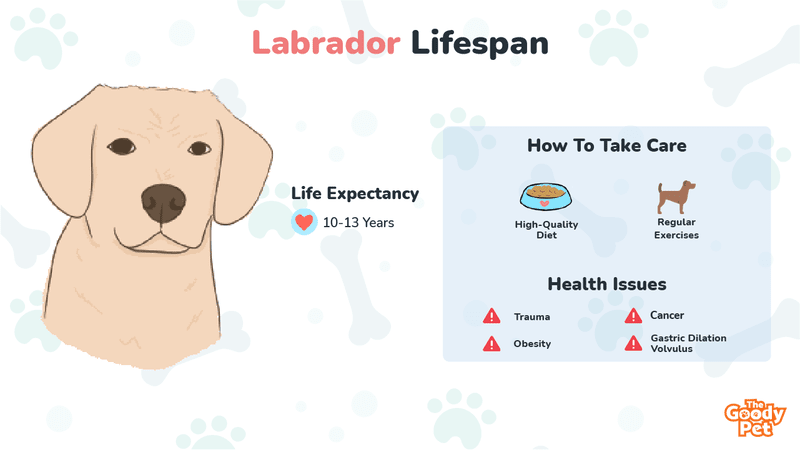Labradors are some of the sweetest dogs you will ever meet. Although the dog breed was initially intended for use as a working breed in fields like hunting, Labs have settled quite comfortably into the life of companion pooches. And they do such a great job at it that anyone who has owned one could testify to wanting theirs to live forever if it was possible. Unfortunately, this is not possible.
Labrador Retrievers have a lifespan of 10 to 13 years. This depends on a number of factors, and the most important ones are how they are cared for and their genetics. It is possible for the Labrador to live longer than this range with the longest living Lab in record reaching an impressive 27 years and 3 months.
If you want or already have a Labrador Retriever, you need to know not just what their average lifespan is but also how to increase the length and quality of life for the pooch. Here is all the information you need for this.
What Age Do Most Labradors Live To?

The average age of a Labrador lives to is about 12 years. To put it more realistically and accurately, it is more of a range from 10 to 13 years.
For some perspective, a 12-year-old Labrador is about 69 years old in human age, which is quite old. The most interesting part is that some even live longer than this reaching the 20th year mark or even more.
Here are some of the factors that determine a Labrador’s individual lifespan.
Genetics
Genetics determine a lot, from health issues to molecular reactions that determine how fast or slow the Labrador will age. This is why some Labs live up to 20 years or more while others with similar health statuses don’t make it past 12 years.
Health Status
Health status in a Labrador is a function of both genetics and care practices. For the most part, Labrador health issues usually affect the quality and not the length of the dog’s life. However, there are some that directly impact how long the dog will live, as you shall find out shortly.
Size
Labradors vary a lot in terms of size, even within the purebred group. They can be medium-sized, weighing around 45 to 50 lbs and standing at 20 inches.
They could also be large dogs measuring upwards of 80 lbs and 22 inches. Smaller Labradors tend to live longer, with the exception of dwarf Labs.
Purebred Or Mixed
The length of life of a Labrador also depends on whether or not it is mixed and, if so, what dog breed it is mixed with. Labs mixed with smaller dogs tend to live longer, with the lifespan sometimes extending to 16 years.
What Do Labs Usually Die From?

Most Labradors die from non-specific complications of old age especially if they were generally healthy and well taken care of doggies.
However, there are a number of health problems that Labs are prone to that may drive them closer to their end. Here are a few of these health issues that you may have to keep an eye out for.
Trauma
Trauma is a serious cause of reduced quality of life and death in Labradors. They are very active and fearless dogs that enjoy the outdoors very much. Unfortunately, this puts them at risk of injury or attacks that could kill them.
Cancer
Cancer is one of the leading causes of death in Labradors. It usually affects the dogs in their older ages but could be seen earlier on in some cases. Some of the most common and devastating cancers affect the gut, reproductive system, or even blood cells.
The best way to help your dog is through early diagnosis, as it gives you more options and better chances of having the dog make it through.
Gastric Dilatation Volvulus
Gastric dilatation volvulus is a condition that occurs when the stomach of the Labrador twists on itself when it is dilated by food or fluids. This can be as harmless as a self-resolving tummy ache or as serious as life-threatening obstruction and strangulation of blood supply to the gut.
Complications Of Obesity
Obesity is very common in Labradors, and though it may not always directly kill the dog, it does expose them to complications that could. The most important one of these complications is a heart disease which eventually results in heart failure and cardiac arrest.
How Do You Know When Your Lab Is Dying?

Labradors unfortunately cannot speak to us to let us know when they are weak or in pain.
However, there are many different ways to tell when your dog is really going through a hard time or when they are dying. Here are some of these signs.
Difficulty Breathing
Healthy Labradors generally do not have trouble breathing. So if you notice your Labrador panting a lot, then it may be a sign that the end is near. This is common with health issues that affect the functionality of the heart and the lungs.
The result is inadequate oxygenation of tissues. This triggers the panting response to get more air into the lungs and more oxygen to the tissues.
Lethargy And Exercise Intolerance
You may also realize that your Lab is no longer enthusiastic about playtime and can barely get through exercise sessions with the same vigor that it is used to. This, of course, is to be expected with old age in Labradors.
However, when it gets to a point where even basic activities like walking around are not welcome, then your dog is not doing okay.
Whining And Howling
Labradors that are on the verge of death are also usually in a lot of pain as a result of whatever underlying condition is bringing their end. One way Labradors express their pain and discomfort is through whining and howling, seemingly at nothing.
Skin Changes
Impending death in Labradors can also trigger skin changes, including dryness of the skin as well as nose and paw pads. The fur is also often affected and may start to thin, dry up, and shed more than usual.
Appetite And Weight Fluctuation
Something else you will find is your dog’s eating habits will change. This is common with all dying Labradors but is particularly noticeable in those that also happen to suffer from obesity.
Hence, the effort to control one’s Labrador food intake should help ensure the health of the pooch, and this intake amount shall be explored in the next section.
How Often Should A Labrador Be Fed?

Speaking of obesity, unhealthy weight gain is usually bad news for Labradors. Ideally, your Labrador Retriever should weigh between 50 to 80 lbs.
Once they pass the upper limit, they head close to dangerous health territory with all manner of risks, including heart disease and diabetes.
The best way to prevent or reverse obesity in your Labrador is by adopting healthy feeding practices for the dog. Here are a few tips that should show you how to go about this.
What To Feed Your Labrador
The best food for a Labrador is a balance of proteins for muscle strength, carbs and fat for energy, and vitamins and minerals for general health and wellbeing.
When choosing a dog food brand to feed your Lab, ensure that you pick brands that use high-quality ingredients and have a good balance of nutrients.
We recommend you try Pet Plate. They fit in all aspects from their human-grade ingredients to the fact that they customize their recipes and portions based on variables like the dog’s breed.
What Not To Feed Your Labrador
Labradors have various food sensitivities like most other dogs. In fact, there are specific foods that, if consumed, could actually poison and kill your Labrador and should thus be avoided at all costs.
Some of these foods that are explicitly bad for your Labrador include chocolate, onions, garlic, chives, grapes, raisins, raw meat, and alcohol.
How Often To Feed Your Labrador
Another aspect of the diet that affects the Labrador’s weight is the number of times that you feed them. Labs are ravenous dogs and will eat whenever they have access to food. This makes free feeding a bad idea.
For the best results in terms of weight management, stick to 4 small meals a day for Labrador puppies and 2 to 3 for adult Labradors.
How Much To Feed Your Labrador
Finally, you have to watch the actual portions you give your Labrador to avoid overfeeding them in terms of quantity. Play it safe with ½ to 1 cup of dry kibble for puppies and 2 to 3 cups for adults per day.
How Much Exercise Does A Lab Need A Day?

Another fantastic strategy to help you maintain a healthy weight range for your Labrador while also improving their health, in general, is regular exercise.
Labrador Retrievers are active and athletic dogs and need about 1 to 2 hours of exercise every day as long as it can be tolerated. For older or sickly Labs, you could work with 30 minutes of exercise every day.
However, there is such a thing as too much exercise. This could wear out the dog, worsen musculoskeletal conditions, or even make them lose interest in physical activity resulting in weight gain.
Here are some signs that your dog has had enough for one day, so you know when to stop.
Panting And Labored Breathing
To be fair, some panting is expected when your Labrador is out for their daily exercise session. However, when it gets to a point where it seems like the dog is struggling to breathe, then you have to call it a day.
Limping And Limb Weakness
This is very common in a condition known as exercise-induced collapse. You may also notice it in Labradors that have joint issues as the prolonged exercise sessions put undue physical stress on them.
Throwing A Fit
Another sign that your Labrador has had enough exercise for the day is when they start to get stubborn or throw fits. This usually happens as a form of protest for the distress that the continued physical activity causes them.
Disinterest In The Activity
Finally, you will know it is time to wrap up your Lab’s exercise session when they stop being responsive to commands or play prompts. They may just lay on the ground and refuse to do anything.
Related Questions
What Is The Longest A Lab Has Lived? The longest Labrador Retriever that ever lived on record is Adjutant, who lived to two years and three months. He was born on 14th August 1936 and died in late 1963 of old age complications. Adjutant is not only the oldest Labrador but also one of the oldest dogs that ever lived across all breeds.
Why Do Labradors Sleep So Much? Labradors need about 12 to 14 hours of sleep every day. If you notice that they are sleeping for longer than that, it is likely that there is an underlying physical or psychological issue. Here are some of the possible reasons why your Lab is oversleeping.
- Lack of physical and mental engagement
- Lack of stimulation
- Boredom
- Loneliness
- Lethargy from physical illnesses
What Makes Labradors Happy? Labradors are easy dogs to keep happy and entertained. Here are a few things that can help you keep your Lab content in your home.
- Quality time and attention
- Good food and treats on the regular
- Cuddles
- Praises and rewards showing approval
- A comfortable nap spot





